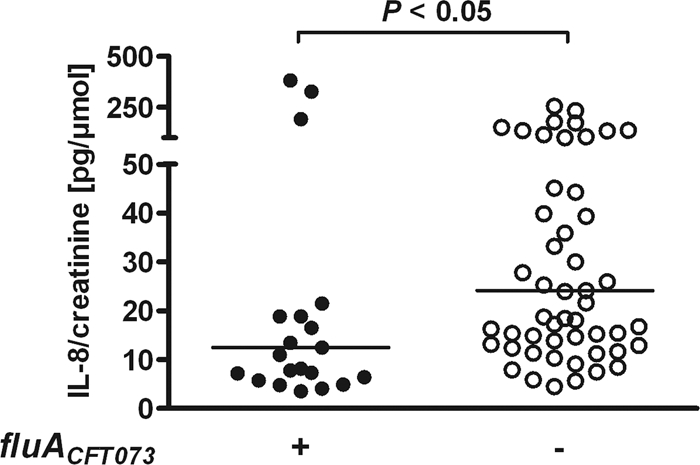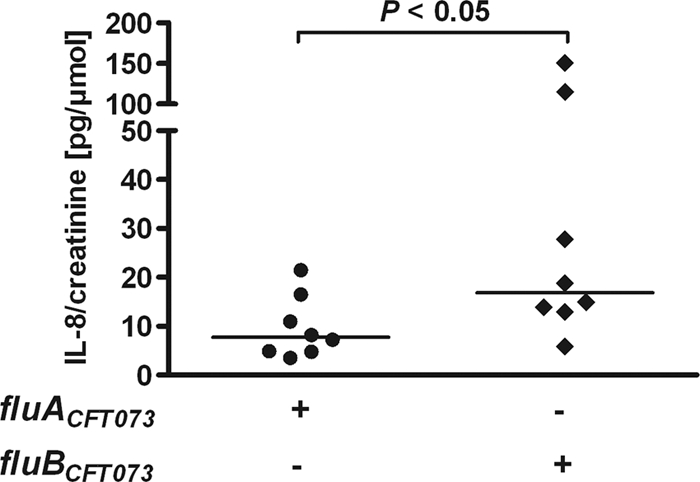Uropathogenic Escherichia coli (UPEC) harbors an arsenal of virulence factors which enable it to infect the host. Adhesion factors of E. coli, facilitating the initial colonization of epithelia and eventually leading to invasion of the host cell, have been described extensively elsewhere (2, 3). More recently, factors supporting E. coli persistence have also attracted increasing interest (6, 7, 11).
Variants of the autotransporter protein Ag43 are expressed by pathogenic as well as commensal E. coli strains (10). By using a mouse infection model, differential functions during pathogenesis were revealed for the two Ag43 proteins in UPEC strain CFT073, encoded by the CFT073 fluA gene (fluACFT073) and fluBCFT073 (9). Whereas Ag43a displayed higher-level autoaggregative properties and promoted persistence in the urinary bladder, Ag43b impaired initial colonization but did not affect later stages of infection. We here investigated clinical UPEC isolates from sporadic versus recurrent urinary tract infections (UTI) to demonstrate the relevance of this observation for human tissue.
A total of 118 E. coli isolates were collected from 47 children with sporadic and recurrent UTI (5). Biochemical differentiation and macrorestriction analyses identified 85 different E. coli strains; 12 strains were repeatedly recovered from the same patients at visits at least 1 month apart (recurrent strains), whereas the remaining strains were isolated only once (sporadic strains). All isolates were tested for the presence of flu (9) and the two CFT073-specific gene variants fluACFT073 and fluBCFT073 (8).
The flu gene was detected in 55 of 85 isolates (65%), and we observed a significant association with isolates from recurrent infections (11 [92%] of 12 such isolates had the gene, versus 44 [60%] of 73 isolates from sporadic infections [P < 0.05]). The overall prevalence for fluACFT073 and fluBCFT073 was 27% each (each gene was present in 23 of 85 isolates). Although neither gene was linked to recurrent strains, the common presence of both genes in one strain was more often found in recurrent than in sporadic strains of the tested collection (5 of 12 recurrent strains versus 10 of 73 sporadic strains [P < 0.05]). Thus, our data support the previously reported linkage between Ag43 proteins and intracellular persistence (1). We further sought for characteristics which could possibly explain the differential roles of fluACFT073 and fluBCFT073 observed during mouse UTI (9).
The neutrophil-attractant chemokine interleukin-8 (IL-8) is assigned a crucial role in bacterial clearance from the urinary tract (4). The IL-8/creatinine ratios in urine samples from children infected with fluACFT073-positive strains were significantly lower than those in samples from children infected with strains lacking this gene (P < 0.05) (Fig. 1), and isolates carrying only fluACFT073 were associated with lower IL-8 levels than isolates expressing only fluBCFT073 (P < 0.05) (Fig. 2). These findings suggest that fluBCFT073 mediates a more immunogenic bacterial phenotype, which could explain the previously reported interference of Ag43b with early stages of infection (9). In contrast, a higher degree of bacterial autoaggregation in strains expressing fluACFT073 (9) might reduce the exposure of immunogenic surface structures, thereby allowing evasion of immune recognition and longer bacterial persistence in the host. Taken together, clinical data from the UPEC collection investigated here support the suggested roles of Ag43 variants in type strain CFT073 and underline the impact of Ag43 proteins on bacterial persistence in the urinary tract. They further indicate that both fluACFT073 and fluBCFT073 might be of advantage for UPEC.
FIG. 1.

IL-8 levels in urine from children with UTI caused by E. coli strains, in relation to the presence (n = 23) or absence (n = 57) of fluACFT073. Individual levels and medians are presented. The difference is significant (by the Mann-Whitney U test).
FIG. 2.

IL-8 levels in urine from children with UTI caused by E. coli strains carrying only fluACFT073 (n = 8) or only fluBCFT073 (n = 8). Individual levels and medians are presented. The difference is significant (by the Mann-Whitney U test).
Acknowledgments
We thank Tiina Tallvik for help collecting the E. coli isolates.
This work was supported by grants from the Swedish Research Council (no. 56X-20356), ALF Project Funding, and the Karolinska Institutet.
Footnotes
Published ahead of print on 31 March 2010.
REFERENCES
- 1.Anderson, G. G., J. J. Palermo, J. D. Schilling, R. Roth, J. Heuser, and S. J. Hultgren. 2003. Intracellular bacterial biofilm-like pods in urinary tract infections. Science 301:105-107. [DOI] [PubMed] [Google Scholar]
- 2.Antão, E.-M., L. Wieler, and C. Ewers. 2009. Adhesive threads of extraintestinal pathogenic Escherichia coli. Gut Pathog. 1:22. [DOI] [PMC free article] [PubMed] [Google Scholar]
- 3.Fronzes, R., H. Remaut, and G. Waksman. 2008. Architectures and biogenesis of non-flagellar protein appendages in Gram-negative bacteria. EMBO J. 27:2271-2280. [DOI] [PMC free article] [PubMed] [Google Scholar]
- 4.Godaly, G., A. E. Proudfoot, R. E. Offord, C. Svanborg, and W. W. Agace. 1997. Role of epithelial interleukin-8 (IL-8) and neutrophil IL-8 receptor A in Escherichia coli-induced transuroepithelial neutrophil migration. Infect. Immun. 65:3451-3456. [DOI] [PMC free article] [PubMed] [Google Scholar]
- 5.Hertting, O., M. Chromek, Z. Slamová, L. Kádas, M. Söderkvist, I. Vainumäe, T. Tallvik, S. H. Jacobson, and A. Brauner. 2008. Cytotoxic necrotizing factor 1 (CNF1) induces an inflammatory response in the urinary tract in vitro but not in vivo. Toxicon 51:1544-1547. [DOI] [PubMed] [Google Scholar]
- 6.Mysorekar, I. U., and S. J. Hultgren. 2006. Mechanisms of uropathogenic Escherichia coli persistence and eradication from the urinary tract. Proc. Natl. Acad. Sci. U. S. A. 103:14170-14175. [DOI] [PMC free article] [PubMed] [Google Scholar]
- 7.Nicholson, T. F., K. M. Watts, and D. A. Hunstad. 2009. OmpA of uropatho-genic Escherichia coli promotes postinvasion pathogenesis of cystitis. Infect. Immun. 77:5245-5251. [DOI] [PMC free article] [PubMed] [Google Scholar]
- 8.Restieri, C., G. Garriss, M.-C. Locas, and C. M. Dozois. 2007. Autotransporter-encoding sequences are phylogenetically distributed among Escherichia coli clinical isolates and reference strains. Appl. Environ. Microbiol. 73:1553-1562. [DOI] [PMC free article] [PubMed] [Google Scholar]
- 9.Ulett, G. C., J. Valle, C. Beloin, O. Sherlock, J.-M. Ghigo, and M. A. Schembri. 2007. Functional analysis of antigen 43 in uropathogenic Escherichia coli reveals a role in long-term persistence in the urinary tract. Infect. Immun. 75:3233-3244. [DOI] [PMC free article] [PubMed] [Google Scholar]
- 10.van der Woude, M. W., and I. R. Henderson. 2008. Regulation and function of Ag43 (flu). Annu. Rev. Microbiol. 62:153-169. [DOI] [PubMed] [Google Scholar]
- 11.Wiles, T. J., R. R. Kulesus, and M. A. Mulvey. 2008. Origins and virulence mechanisms of uropathogenic Escherichia coli. Exp. Mol. Pathol. 85:11. [DOI] [PMC free article] [PubMed] [Google Scholar]


